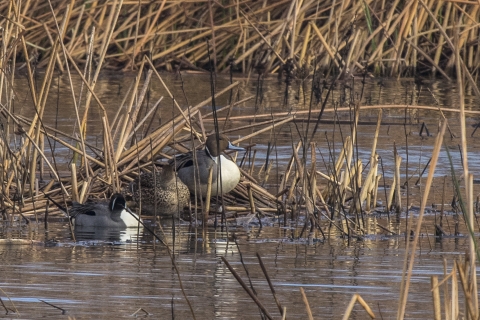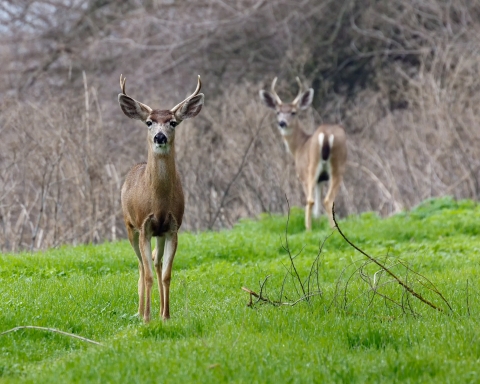Seasons of Wildlife
Nature’s Calendar at San Luis NWR
January
- Numbers peak for geese and ducks
- Wetlands fully flooded
- Bald eagles often observed hunting on refuges
- Winter sees greatest diversity of raptor
February
- Tule elk bulls shed antlers
- Great horned owls hatching
- Hawks exhibiting aerial courtship displays
- Large numbers of wintering waterfowl and cranes visible
March
- Waterfowl begin migrating north
- Hawks and herons nesting
- Shorebird numbers building
- Snakes encountered basking in the sun
April
- Wildflowers are abundant around vernal pools
- Tule elk cows begin giving birth to calves
- Seasonal wetlands are drained to allow waterbird food plants to grow
- Peak number of shorebirds
- Summer neotroprical songbirds begin arriving
May
- Shorebirds are migrating in breeding plumage
- Songbirds are very vocal defending nesting territories
- Tiger salamanders return to burrows as vernal pools dry
June
- Tule elk antlers fully grown with velvet falling off
- Shorebirds migrate north
- Seasonal wetlands are dry
- Songbird and raptor fledglings are visible
July
- Seasonal wetlands are irrigated to encourage waterbird food plants to thrive
- Fall shorebird migration begins
- Coyote pups out exploring their territories
August
- Swainson's hawks have fledged and will form "kettles" over grasslands
- Irrigated pastures attract ibis and long-billed curlews
- Tule elk rut and bugling peaks
- Some early northern pintails arrive
September
- Sandhill cranes begin returning mid-month
- Songbirds migrate south
- Monarch butterfly fall migration peaks
- Black-tailed deer rut begins
October
- Aleutian cackling geese arrive at the San Joaquin River NWR
- Greatest bird diversity occurs during fall and spring migrations
- Juvenile snakes emerge
November
- Over 15,000 Sandhill cranes are in the Grasslands by Thanksgiving
- Ross’ and white-fronted geese arrive
- Tiger salamanders begin trek to vernal pools to breed
- Large numbers of ducks present
December
- Snow geese begin to arrive at Merced NWR
- Swans may arrive in small numbers
- Watch for eagles, falcons, and ferruginous hawks
- Black-tailed deer can be spotted at the San Luis NWR throughout year, most often at the West Bear Creek Unit and waterfowl tour route
Featured Species
Learn more about several key wildlife species at the refuge.
Northern Pintail
Northern pintails were once among the most abundant ducks in North America. Their numbers have dropped dramatically due to the loss of grassland habitat, including key migration and wintering habitats in the Klamath Basin and California’s Central Valley. Strategies for recovering the northern pintail focus on preserving and enhancing these habitats for the ducks throughout the country, including the Prairie Pothole Region in the central United States and Canada, as well as major wintering areas in California.
Tule Elk
Tule elk are one of 4 subspecies of elk in North America. Found only in California, tule elk once thrived in the state’s Central Valley and numbered about 500,000 animals. Then their numbers began declining in the 1800s as their habitat shrank and as market hunters killed the elk to feed miners during the Gold Rush. In the 20th century, the tule elk neared extinction when their population plunged to fewer than 40 individuals. In 1974, to help recover the elk, the California Department of Fish and Wildlife worked with the refuge to establish a herd in an enclosure on the San Luis NWR. The herd thrived and has been used to establish new herds or boost existing herds in California. The state’s tule elk population has now grown to more than 4,000 animals in more than 20 distinct herds—a true success story.
Long-Billed Curlew
California’s Central Valley provides important winter habitat for the long-billed curlew, one of the largest shorebirds in North America. The curlew population has dropped significantly in the past 150 years as its grassland habitat has disappeared or has been taken over by invasive plants. Strategies for recovering this bird include managing grasslands to remove invasive plants and increasing the amount of habitat for this bird.
Black-Tailed Deer
Prior to 1850, black-tailed deer were present throughout the northern San Joaquin Valley – but the deer vanished from the area due to over-hunting, habitat loss, and physical barriers to migration. In recent decades, the California Department of Fish and Wildlife began a program to reintroduce the deer to the refuge and to other suitable areas in the valley. These relocated deer have produced a number of offspring, resulting in a thriving population on the refuge. Deer are often seen from every auto tour route and nature trail on the refuge.






